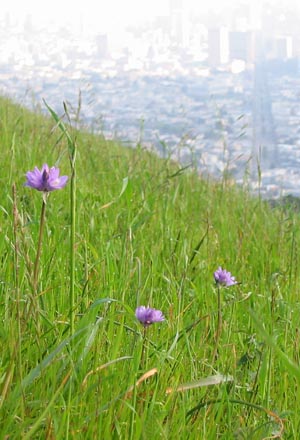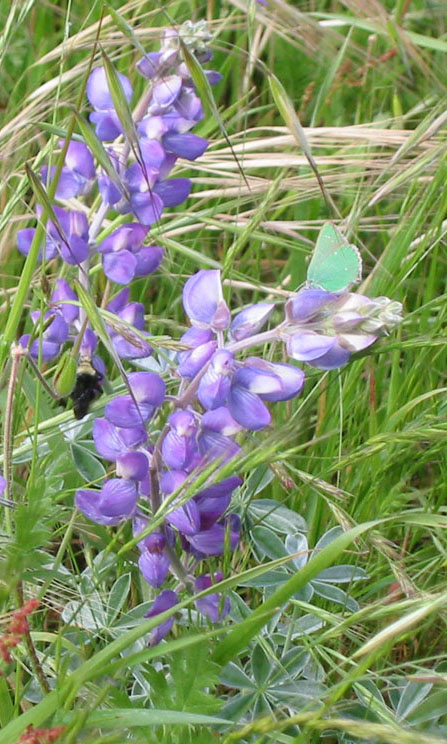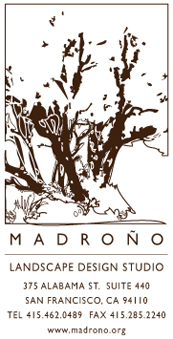 Once upon a time, Twin Peaks stood as one mountain, a united man and wife. But the couple quarreled long and bitterly, until at last the Great Spirit cleaved them with a bolt of lightning. The neighborhood has been quiet ever since -- or so say the chroniclers of Indian legend.
Once upon a time, Twin Peaks stood as one mountain, a united man and wife. But the couple quarreled long and bitterly, until at last the Great Spirit cleaved them with a bolt of lightning. The neighborhood has been quiet ever since -- or so say the chroniclers of Indian legend.
Those Indians, alas no longer here to confirm or deny the tale, likely marked a drastic change in the neighborhood with the arrival of the Spaniards, who fortified the nearby Presidio in 1776 . Maps from this period call Twin Peaks "Los Pechos de la Choca" or "The Breasts of the Indian Maiden," of whom General Vallejo's botanically minded son once remarked, "Never have I seen a cultured woman half so fair as this untaught, unadorned daughter of the wilds."
Young Vallejo may in fact have personified the Franciscan flora, the smallest floristic region in California. This curvaceous landscape of flinty chert and sand dunes supports a body of low-growing coastal scrub and grassland reclining between the regions of Mendocino/Sonoma to the north and the Santa Cruz mountains to the south, both of which favor a taller Douglas fir-redwood association all the way down to the sea. Rich with texture, aroma, and color, our fair maiden helps us define our local identity. Her toes curl around Sign Hill, blazoned with "South San Francisco: The Industrial City" in block letters visible from the freeway and the airport. Her long legs are San Bruno Mountain, stretching for several miles of the inner peninsula with Brisbane and Colma snuggled on either side. Above the rude garter of Daly City her saucy flank swells at Mt. Davidson, then slims to a waistline and rises again to the torso topped with Twin Peaks, shoulders at Diamond Heights and Corona Heights, arms embracing Sunset Heights and Bernal Hill, with long tresses of serpentine flowing out to Bayview and into the Presidio.
Here we find bunchgrasses like native blue grass (Poa unilateralis), purple needle grass (Nassella pulchra), and red and Idaho fescue (Festuca rubra and F. idahoensis) anchoring ecosystems tens of thousands of years old. The delicate rose-purple flowers of coast rock cress (Arabis blepharophylla) cling to red peaks of wind-ravaged rock, while blue and white lupines, golden poppies, blue dicks, and pink checkerblooms (Sidalcea malviflora) beckon from the grasslands to the pleasure of hungry butterflies.
 The site of Twin Peaks enjoys special scientific status as the "type locality" of the endemic, rare and endangered Mission Blue butterfly, where the first specimens of the species were collected. The creature's lifecycle begins with eggs laid on the leaves of silver lupine (Lupinus albifrons, L. albifrons var. collinus and L. variicolor). The tiny larvae hatch and feed for a time, then burrow under the plant and lie dormant for the winter in the roots. Come February or March, the caterpillars emerge to fatten further on the lupine's feathery foliage, then spin their cocoons on the stems and flower spikes. April and May witness the extraordinary Mission Blues take wing, often spied resting on a lupine, nectaring at the flowers of a coast buckwheat (Eriogonum latifolium), or punctuating the breeze with whimsical fluttering color. The strongest populations of lupine and buckwheat grow on the grassy hill just south of the southern peak, embraced by the road's hairpin turn, so that's where to go look for the butterflies. Without these larval and mature food plants, the Mission Blue would join the Pheres Blue and the Xerxes Blue in extinction.
The site of Twin Peaks enjoys special scientific status as the "type locality" of the endemic, rare and endangered Mission Blue butterfly, where the first specimens of the species were collected. The creature's lifecycle begins with eggs laid on the leaves of silver lupine (Lupinus albifrons, L. albifrons var. collinus and L. variicolor). The tiny larvae hatch and feed for a time, then burrow under the plant and lie dormant for the winter in the roots. Come February or March, the caterpillars emerge to fatten further on the lupine's feathery foliage, then spin their cocoons on the stems and flower spikes. April and May witness the extraordinary Mission Blues take wing, often spied resting on a lupine, nectaring at the flowers of a coast buckwheat (Eriogonum latifolium), or punctuating the breeze with whimsical fluttering color. The strongest populations of lupine and buckwheat grow on the grassy hill just south of the southern peak, embraced by the road's hairpin turn, so that's where to go look for the butterflies. Without these larval and mature food plants, the Mission Blue would join the Pheres Blue and the Xerxes Blue in extinction.
Silver lupine and coast buckwheat look smashing together in the garden; they both grow in clumps to around 1 foot tall, the former with silvery palm-shaped leaves and a blue-and-white pea flower, the latter with dun spoon-shaped leaves and a big bloom of red to pink umbels. They should both be considered key elements in any San Francisco native landscape, particularly in the neighborhoods around Twin Peaks and San Bruno Mountain, the only places on earth with the Mission Blue butterfly.
Twin Peaks also boasts "type locality" status for Phacelia californica, the low-growing perennial that drives native bees mad with delight. Look for the blue-green leaf blades and tight clusters of lavender flowers -- an especially vigorous population flourishes in the full sun on the south-facing slopes of the north peak.
Today these metaphoric breasts of the Franciscan region are adorned with the raiment of progress -- the ribbon of Portola Drive pulled tight around her waist, a three-pronged radio tower perched on her clavicle, a 300-million-gallon reservoir cradled in her armpit, and a split roadway describing a perfect figure-8 around the tips of her formidable bosom. Busloads of tourists pose on the stone brassier of an observation deck, taking snapshots of the remarkable city of San Francisco spread below them like a book cracked open to Market Street.
Despite these accoutrements and the slow creep of subdivisions up her ribcage, the Twin Peaks still nurse remnants of the original Franciscan flora, thanks to the stewardship of city and community groups. A quarter-century ago, this natural area was faring badly under the onslaught of traffic, cars and hikers and yes, even off-road motorcycles taking those twin peaks roller-coaster style. Invasive weeds gripped the disturbed landscape, looking to smother it. But in the late '80s, the city enlisted the San Francisco Conservation Corps to build meandering footpaths to the top of each peak, with railroad ties for steps, and to install massive timber barriers at the trailheads, putting a stop to marauding motorbikes. A team of local volunteers with shovel and pick erased the rutted dirt bike tracks, rooted out damaging tangles of broom, cotoneaster, ehrharta, and ice plant, and fortified the surviving population of native plants with seeds and plantings of bunchgrass, monkeyflower, Douglas iris, silver lupine, coast buckwheat, and many others. Since then, the city's Natural Areas Program (NAP) has played a vital role in maintaining this indigenous biodiversity, controlling the spread of mustard, radish, broom, Italian thistle, English ivy, and other domineering monoculturalists.
The NAP recently has faced violent opposition from a group of dog owners who accuse the "plant people" of hijacking public land and fencing off common ground into a hands-off botanical museum. A recent letter to the editor of the Chronicle, for example, accused native plant boosters of "racism" for discriminating against "non-natives," and compared the native plant movement to Nazi Germany. The plant people accuse the "dog people" of selfish myopia and ignorance for failing to understand the difference between horticulture and natural stewardship. The situation has become so polarized, with the finger-pointers and name-callers shouting at each other in tones increasingly hostile and shrill, the two sides are starting to sound alike, and losing sight of the real issues at stake.
Humans are the only invasive species with the ability to make moral decisions, and therefore we should practice stewardship of the life forms that lived here first. No single species holds more importance than the natural diversity to which it contributes; the network of connections between living organisms remains most valuable of all. This holds particularly true at the intersection of natural and urban, where the activities of mankind operate at high concentration and their effects on the surrounding web of life are most severe.
If we cannot stop our squabbling, perhaps the Great Spirit will intervene with a bolt of lightning. Meanwhile, Twin Peaks are abloom with history. Go take a walk there and savor your connection with the millennia. Better yet, volunteer for the NAP (call 753-7268) or write your supervisor in support of natural stewardship. The power of many is stronger than the cult of one.
* * *
Geoffrey Coffey wrote this article from a rental apartment on the eastern slope of Twin Peaks, living at the breast of the Francisco flora. He is the founder of Madroño landscape design studio, a principal of Bay Natives nursery, and a freelance writer for the San Francisco Chronicle.

